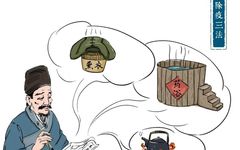
Click on the “blue word” to follow us!
In the current battle against the COVID-19 pandemic, Traditional Chinese Medicine (TCM) has played an important role. As the sacred text of TCM, the Ben Cao Gang Mu (Compendium of Materia Medica), compiled over 500 years ago, recorded many effective methods for disaster prevention and epidemic control.
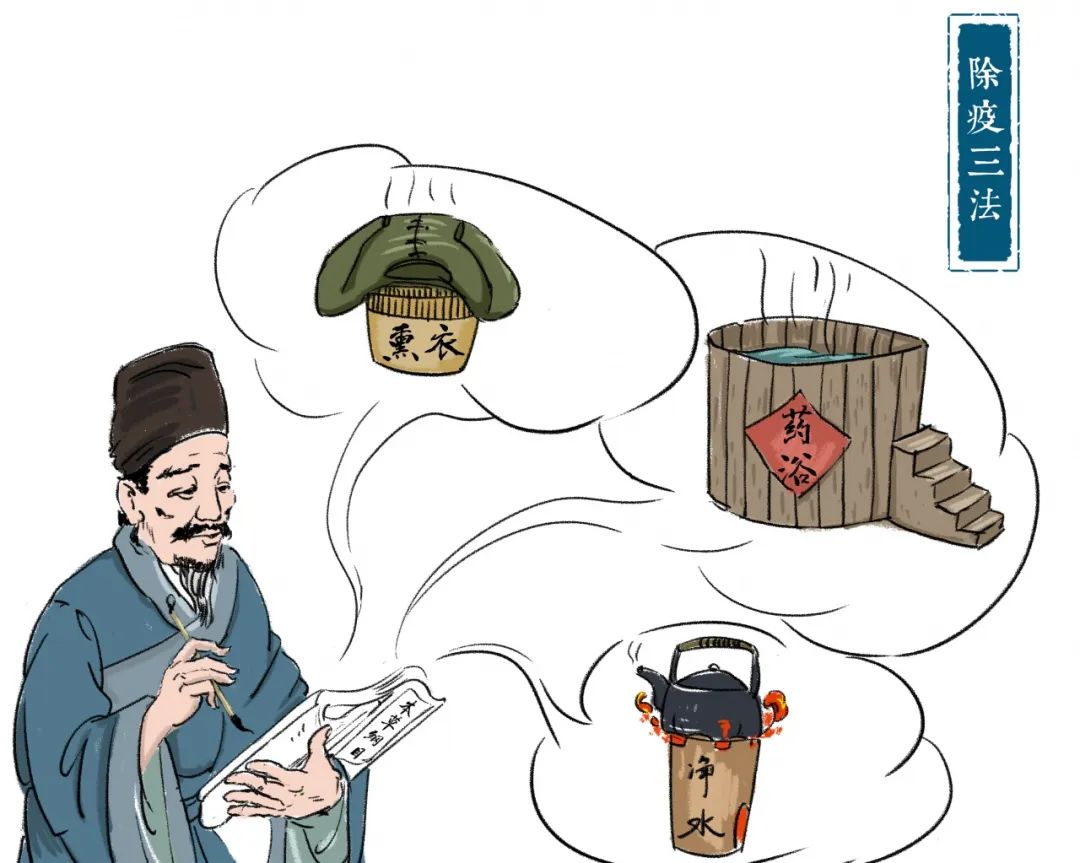
In terms of air disinfection, burning Chen Xiang (Agarwood), Mi Xiang (Honey Fragrance), Tan Xiang (Sandalwood), Jiang Zhen Xiang (Incense), and An Xiang (Benzoin) can have epidemic prevention effects. For high-temperature steaming disinfection, “When the plague strikes, take the clothes of the initial patient and steam them in a pot, then the whole family will not be infected.”[1] Steaming contaminated clothing at high temperatures to prevent further infection is also a very scientific method by today’s standards.
In terms of medicinal baths for disinfection, using a decoction of Bai Mao Xiang (Imperata cylindrica), Mao Xiang (Acorus calamus), and Lan Cao (Orchid grass) for bathing can dispel epidemic qi. In terms of medicinal epidemic prevention, the Ben Cao Gang Mu has a dedicated section on epidemic treatment, gathering a large number of prescriptions for epidemic prevention, such as Cang Er Zi (Xanthium) taken in powder form with water to dispel evil, Tao Ren (Peach Kernel) and Zhu Yu (Evodia) stir-fried with salt to chew for preventing pestilence, and garlic juice taken to treat seasonal febrile diseases, among others.
In terms of water disinfection, Li Shizhen believed that “water is the source of all transformations,” and the quality of water is crucial for human health. Water from ditches near cities is often polluted; if it must be used, it should be boiled and allowed to settle for an hour before drinking.[2]
However, many people do not know that the publication process of the Ben Cao Gang Mu was fraught with difficulties.
It is said that the great literary figure Wang Shizhen was the one who recognized the value of the Ben Cao Gang Mu, as his preface referred to it as “the secret record of emperors and a treasure for the people.” However, few know that Li Shizhen had sought a preface from Wang ten years earlier without success…
Some say that the bookseller Hu Chenglong recognized the true dragon and helped the Ben Cao Gang Mu achieve historical significance. But why did it take six years for the book to be engraved and printed?
Alas, Li Shizhen passed away in the third year of waiting for publication in Nanjing. He never saw the work that consumed his life come to fruition, nor did he anticipate that the book would receive the emperor Wanli’s personal approval, or that he would be posthumously honored as “the saint of medicine” and “a great natural scientist” by various circles at home and abroad.
What is the truth of history?
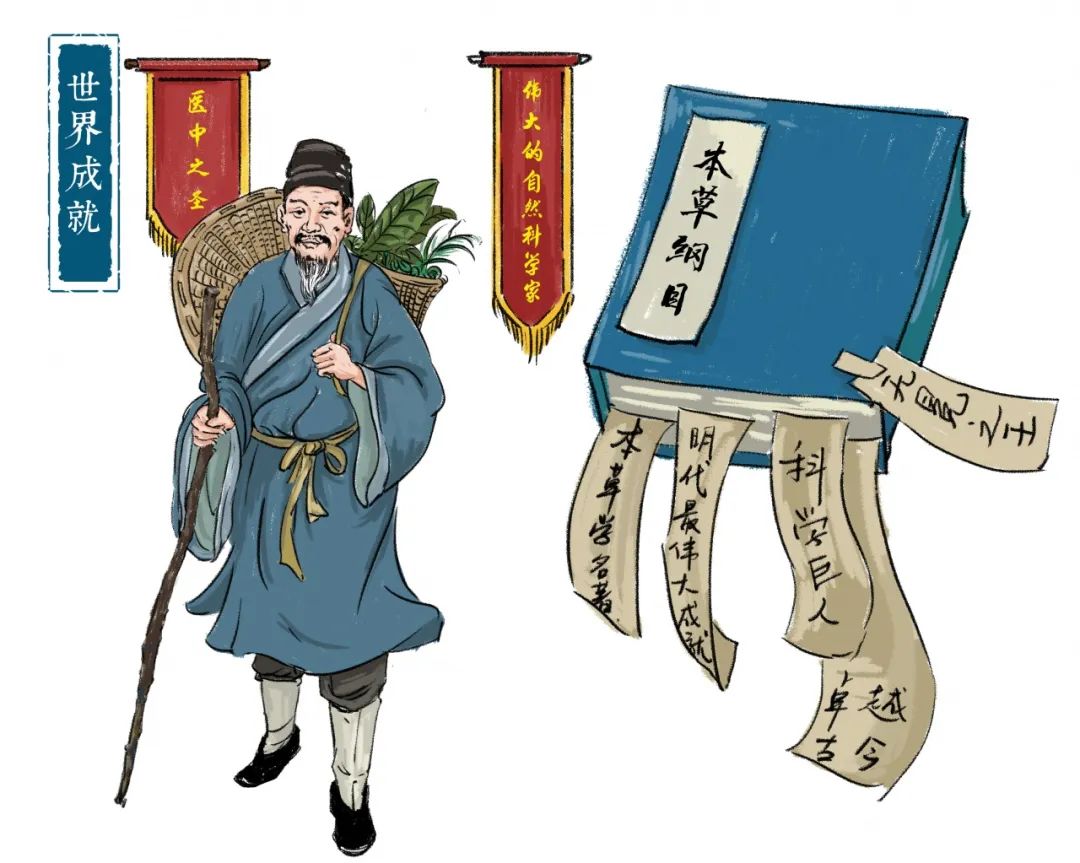
► The Ben Cao Gang Mu is a monumental work in the history of TCM
1
“Repeated attempts to gain fame but failed”—— Changing careers to medicineLi Shizhen was born in the thirteenth year of the Zhengde era (1518) in a well-off family in Qizhou (now Qichun County, Hubei Province). His father, Li Yanwen, was a physician who had served in the Imperial Medical Institute in the capital.[3]Being selected as a consultant for the highest medical institution in the country from a county doctor a thousand miles away was quite remarkable.Thus, the Li family was well-known locally.However, initially, Li Shizhen did not follow in his father’s footsteps but chose the path of the imperial examination.In the Ming Dynasty, the imperial examination was an important way for commoners to achieve prominence, and becoming an official was the first choice for most scholars, which was also the case for the book-loving Li Shizhen.[4]He passed the first level of the examination at the age of 14, but failed to pass the provincial examination in Wuchang three times in the years 1534, 1537, and 1540.
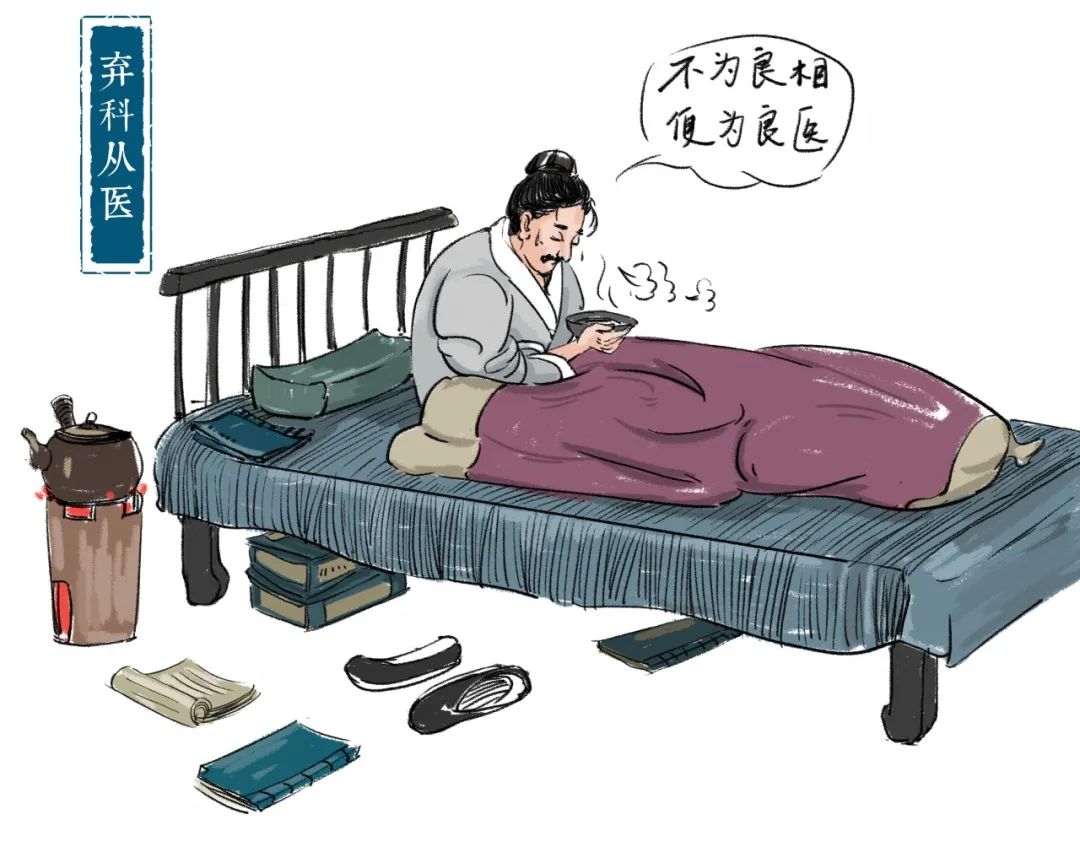
► Li Shizhen, who was obsessed with the official path, realized that “the wonders of medicine are indeed profound!”
In the summer of 1537, Li Shizhen fell seriously ill due to a cold that led to “bone steaming” (pulmonary tuberculosis), and after a month of worsening symptoms, he was thought to be near death. However, after taking a prescription prepared by his father, he miraculously recovered in less than two days. This experience made Li Shizhen realize the profoundness of medicine, which significantly influenced his future life path.[5]
After 1540, after three failed attempts at the imperial examination, Li Shizhen decided not to take the exams anymore, stating, “If I cannot be a good minister, I will be a good doctor.” The deep family tradition provided him with a new life path. He returned home and “studied for ten years without leaving the courtyard,” living a life of extensive reading and medical research.[6]From then on, his medical skills improved, and his reputation gradually spread. More importantly, he had a heart for helping others, as reflected in the saying, “Traveling a thousand miles to deliver medicine without charging a fee.”[7]
2
“At thirty, I strive to edit and compile”—— Personal responsibility for the national pharmacopoeia Practitioners of medicine must be well-versed in pharmacopoeias. In ancient China, pharmacopoeias were generally referred to as Ben Cao, starting with the Shen Nong Ben Cao Jing (Shen Nong’s Classic of Materia Medica) from the Han Dynasty, which has been annotated and expanded by physicians throughout the ages. The Tang Dynasty’s official pharmacopoeia established the tradition of government-organized pharmacopoeia compilation. By the Ming Dynasty, there were over 41 pharmacopoeias in circulation, mostly old works from previous dynasties, with inconsistent formats and outdated content.Li Shizhen, during his practice, felt that various pharmacopoeias were filled with errors and misled the public, stating, “Some items are split into two or three, while others are confused as one.” Thus, he conceived a bold idea: to revise the pharmacopoeia. This was a bold undertaking because since the Tang Dynasty, the revision and publication of pharmacopoeias had mainly been undertaken by the government, with large-scale compilations during the reigns of emperors such as Gaozong of Tang, Taizu of Song, and others. Although there were related writings in the Yuan and Ming Dynasties, they focused on specific aspects, and it was nearly impossible for a private individual to systematically reorganize and revise a pharmacopoeia without significant manpower, financial resources, and material support.When Li Shizhen contemplated this grand project, he found that among his contemporaries in the Ming Dynasty, many had greater prestige, more experience, and higher status than him; apart from his solid medical foundation, his only direct advantage was his grand ideal and enduring patience. He was determined to undertake this project! Without government funding, the research team consisted of his family members.[8]Taking on the national project alone was undoubtedly a daunting task.Had he chosen to focus solely on practicing medicine and educating the next generation, his family life would have been much easier. However, his ideals and patience drove him to pursue this path relentlessly…In the thirty-first year of the Jiajing era (1552), the local physician Li Shizhen from Qizhou embarked on the long journey of compiling the pharmacopoeia, “fishing for books and gathering knowledge from various sources” and “exhaustively searching and collecting” for nearly 30 years…
3
“I wish to ask for a word to ensure immortality”—— A decade of seeking a preface for publicationIn the sixth year of the Wanli era (1578), the manuscript of the Ben Cao Gang Mu was completed, comprising 52 volumes divided into 16 sections and 60 categories, listing a total of 1,892 medicinal substances, with 374 new substances added, 11,096 prescriptions, and 1,109 illustrations.However, the completion of the manuscript was just the beginning. The biggest problem facing Li Shizhen was: who would fund the publication of such a massive work? During the Ming Dynasty, the publishing industry was thriving, and printing technology was advanced, but the prosperity of the publishing industry had no direct relation to Li Shizhen. A work of this scale, without the necessary funding and not being a popular topic, could only rely on the author to self-finance or seek donations; otherwise, it would be impossible to publish.How much money was needed to publish the book?
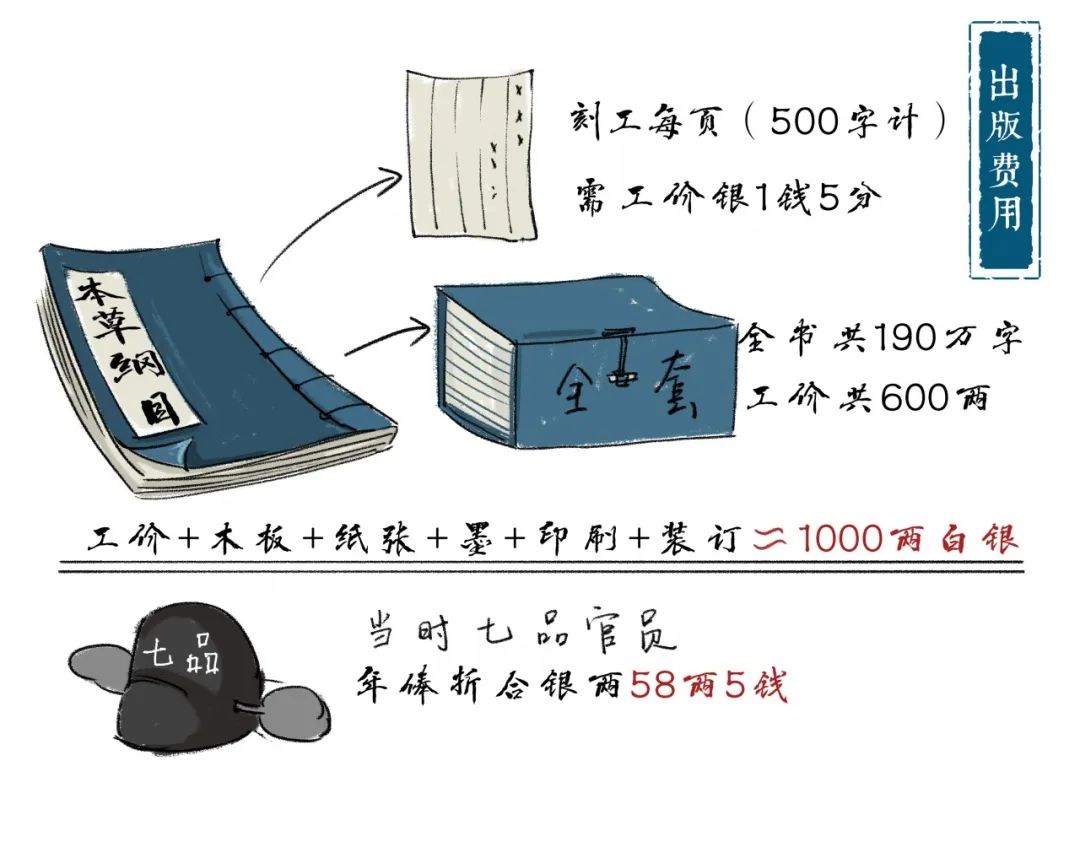
► Comparison of salaries and publishing costs in the Ming Dynasty
In the Ming Dynasty, the cost for engravers was 1.5 cash per page (based on 500 characters), and the Ben Cao Gang Mu has a total of 1.9 million characters, which means the engraving cost alone would be nearly 600 taels of silver. Adding the costs of woodblocks, paper, ink, printing, and binding, the total would be around 1,000 taels of silver.
At this time, what was Li Shizhen’s financial situation? Among the Li family, his son Li Jianzhong was serving as the magistrate of Pengxi in Sichuan, a seventh-rank official with the highest income, earning an annual salary equivalent to 58 taels and 5 cash. Given Li Shizhen’s medical ethics of often treating patients without charge, the family’s annual income from medicine could only be less than this salary. Even if Li Jianzhong donated his entire salary, it would take over ten years to gather the 1,000 taels needed. Clearly, self-financing for publication was not feasible.
Unable to afford the costs, he had to seek help from patrons. Li Shizhen first sought funding in nearby Huangzhou and Wuchang, either approaching government offices for publication funds or pleading with booksellers for assistance, but to no avail.
One can imagine the scene at that time; wherever he went, Li Shizhen’s efforts were met with praise: “Such a work is truly rare,” “Your spirit is commendable,” but when it came to publication, they would say, “The costs are simply too high, and our resources are limited; you should try elsewhere.” After nearly a year of seeking, there were no results.
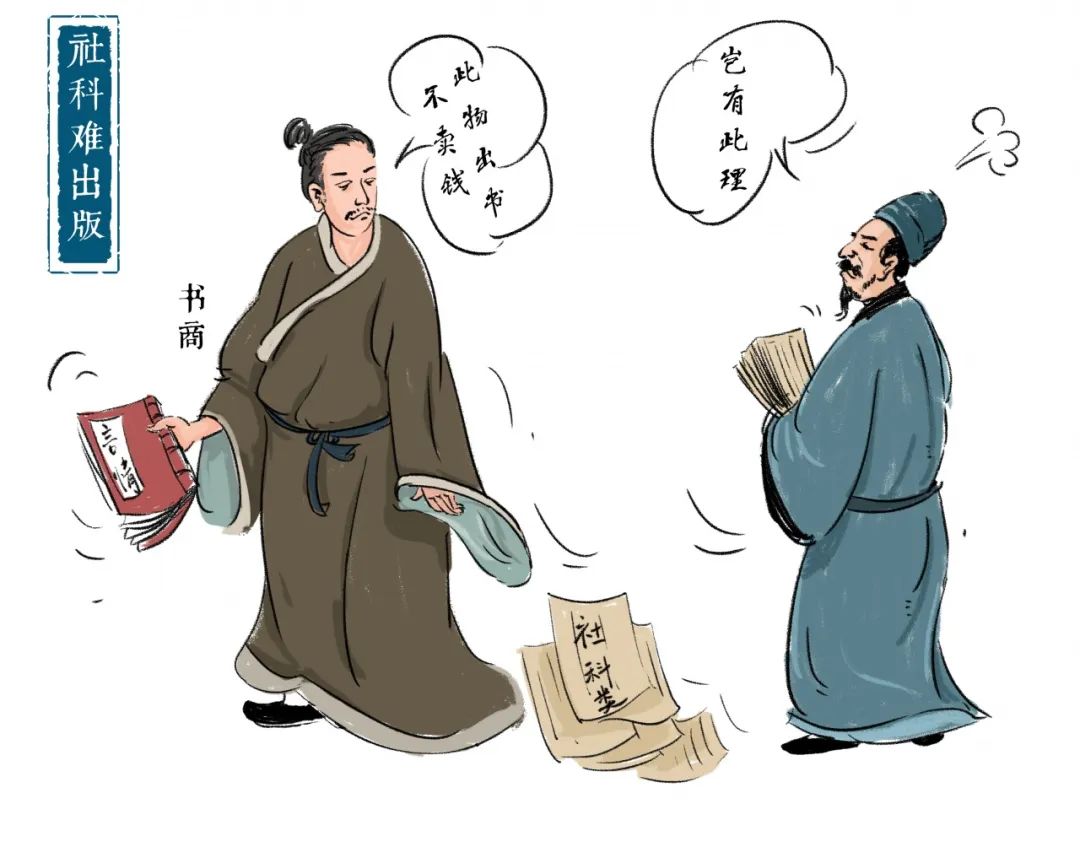
► In the Ming Dynasty, booksellers were also hesitant to publish scholarly works.
With no success in his hometown, he decided to try his luck in Nanjing. As one of the capitals of the Ming Dynasty, it was a famous center for book publishing. In the seventh year of Wanli (1579), at the age of 63, Li Shizhen went to Nanjing to seek publication opportunities for his work. “Jinling is the capital of books,” with numerous publishing houses, but after a year of searching, not a single bookseller was willing to publish the book.The consensus among booksellers was that they preferred exciting content, illustrated novels, and plays, especially those with thrilling plots and romantic elements that would be more popular among the public. Practical books, such as exam simulation questions (preferably with endorsements from famous scholars), also had a significant market. This old man from Hubei with his dictionary of medicinal substances had no market appeal, no fame, and even if printed, no one would buy it. During his market search, someone advised Li Shizhen that since government funding was unlikely, the only feasible way was to have a famous person write a preface to recommend the book, which might persuade booksellers to publish it.The most famous person at the time was Wang Shizhen, a leading figure in the literary world, known for his high talent and reputation. Many sought him to write prefaces, and it is said that he wrote as many as 319 prefaces for others. Of course, when approaching him for a preface, a generous fee was likely expected, and once he agreed, the value of the work would significantly increase.[12]In September of the eighth year of Wanli (1580), Li Shizhen traveled down the river to Wang Shizhen’s home in Taicang, saying, “I wish to ask for a word to ensure immortality.” At that time, Wang was deeply engrossed in Taoist practices, and when Li arrived, Wang was preparing a “transcendence ceremony” for his much younger female disciple, Wang Taozhen.[13]Given the circumstances, the differences in worldview between Wang Shizhen and Li Shizhen were vast; one revered Taoist practices while the other held them in disdain, making mutual understanding difficult.
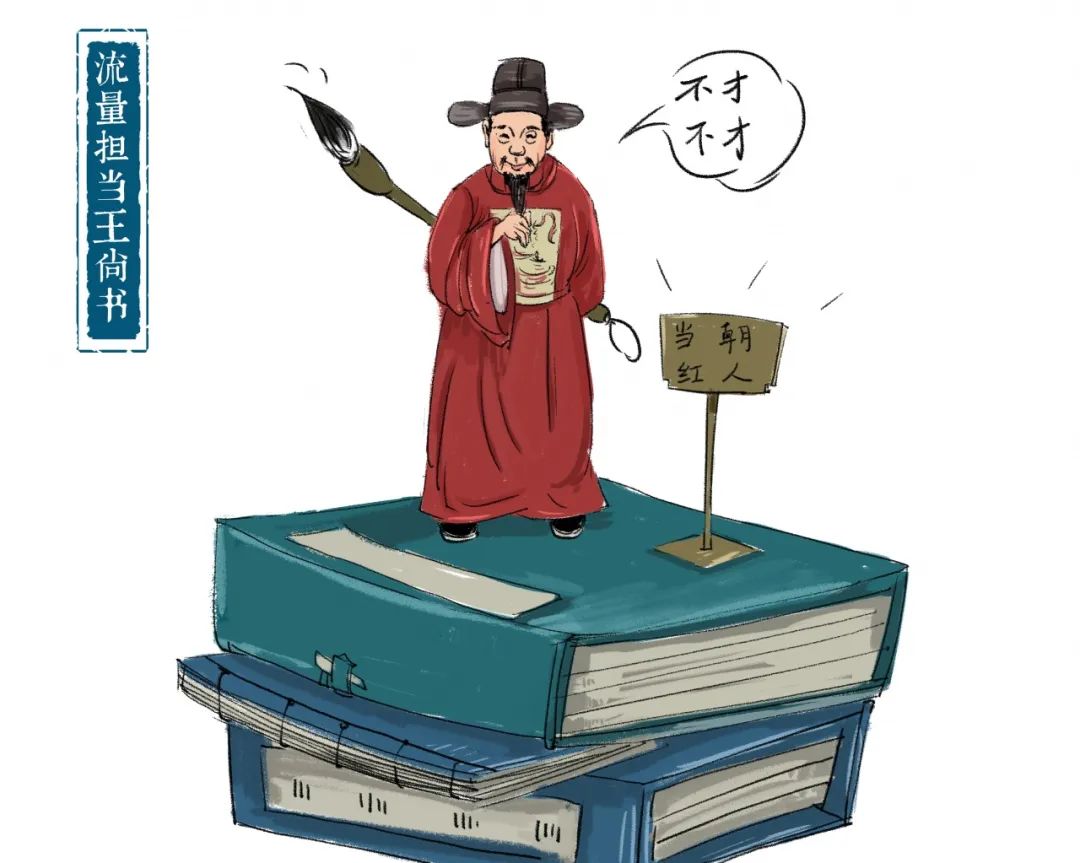
► Wang Shizhen was a significant figure in the literary world at the time.
After some polite exchanges, Wang did not indicate whether he would write a preface for Li, but instead wrote a poem for him, stating it was a “playful gift.” The poem read: “Li, you resemble the tree by the river, and I see the immortal crossing the dragon. You bring forth the book from the blue bag, seeking a preface from the master. The true essence of Huayang is to transcend, but annotating the pharmacopoeia delayed me for ten years. Why not let your son do it instead, and focus on your own transcendence?”Analyzing this poem reveals many allusions, filled with mockery and advice, suggesting that while Li Shizhen sought a preface, he was being advised to focus on his own pursuits instead. This reflects the traditional Chinese practice of politely declining requests while maintaining courtesy.Although later generations have interpreted this poem with idealistic goodwill, the reality was that Li Shizhen left empty-handed after seeking Wang Shizhen’s preface. In fact, the difficulty in obtaining a preface from Wang Shizhen can be understood from a preface he wrote for a friend, Hu Yinglin, the following year: he felt troubled by requests for prefaces, not wanting to flatter insincerely or disappoint others, and thus decided not to write prefaces for anyone anymore.[14]Perhaps Wang Shizhen thought that although there was a fee, he did not lack money, and since he was not familiar with Li, he had the right to refuse.Li Shizhen’s mood was likely not very good either; since he could not obtain a preface, he could not publish the book. So he returned home to continue revising the manuscript and wait…Ten years later, in the eighteenth year of Wanli (1590), Li was already seventy-three years old. As the saying goes, “At seventy-three, eighty-four, one goes to the underworld without being invited.” At this time, Li Shizhen was suffering from old age and illness, and he felt that if he did not try again, he might not see his work published in his lifetime. Thus, he approached Wang Shizhen for the second time. Moved by Li’s persistence, Wang finally wrote the preface, describing the scene of their meeting: a frail old man enthusiastically introducing the Ben Cao Gang Mu, likening him to “a person south of the Big Dipper.” Wang then recorded a summary of Li Shizhen’s self-description. After “carefully reading and enjoying” the work, Wang Shizhen’s attitude was markedly different from ten years prior, lamenting that this book should not be viewed merely as a medical text, but as “the subtle essence of nature and principles, a secret record for emperors and a treasure for the people,” and praised Li Shizhen, saying, “Li, your dedication is truly commendable!” The preface was completed in the same year that Wang Shizhen passed away.
4
“The book remains for review, the Ministry of Rites is informed”—— Posthumously awarded the title of Taixue Hospital JudgeWith Wang Shizhen’s preface, the bookseller Hu Chenglong decided to take a risk, believing that sales should not be a problem, although he was uncertain about the volume. History played a joke on Hu, as he likely never imagined that after a lifetime of publishing many books and earning considerable profits, the work that would immortalize him would be the Ben Cao Gang Mu, which had initially been overlooked.Engraving and printing take time, and as a profit-driven businessman, Hu Chenglong could not afford to let craftsmen spend too much time on a work with uncertain profitability. How long did it typically take to engrave and print a book of similar content at that time? In the second year of Jiajing (1523), the Shandong government engraved the Zheng Lei Ben Cao in one year. In the thirty-first year of Wanli (1603), the governor of Jiangxi, Xia Liangxin, reprinted the Ben Cao Gang Mu, which took six months to engrave and print; in the thirteenth year of Chongzhen (1640), the bookseller Qian Weiqi reprinted the Ben Cao Gang Mu, which took eight months.Three years later, in the twenty-first year of Wanli (1593), while the book was still being engraved, Li Shizhen, who was waiting for publication in Nanjing, passed away, never seeing his work published. Three years after Li’s death, the Ben Cao Gang Mu was finally printed, taking six years from engraving to publication. The delay was not due to the author’s revisions but rather the bookseller’s issues. After nearly 30 years of effort, with three revisions of the manuscript, the aging and ailing author only hoped to see the book published quickly and would not trouble the publisher again. Thus, the difficulties of publication are evident. In six years, if funds were sufficient and conditions met, ten similar books could have been printed.What might Li Shizhen have thought before his death? Given his attitude towards writing, he likely thought that the engraving must not have any errors, and he wanted to present the book to the court to attract attention, hoping that once published, people would no longer suffer from the mistakes of previous generations.In November of the twenty-fourth year of Wanli (1596), Li Shizhen’s second son, Li Jianyuan, a scholar from Huangzhou, went to the capital to present the published 58 copies of the Ben Cao Gang Mu and his father’s memorial to the court. This was because two years earlier, in the twenty-second year of Wanli (1594), the court had ordered the collection of lost books while compiling the national history. In his memorial, Li Jianzhong stated, “Just as the book was completed, my father suddenly passed away.” This was undoubtedly a comforting statement; otherwise, he would not have waited three years after the book was completed to present it. If Li Shizhen’s memorial was filled with hope for the court, Li Jianzhong’s memorial reflected a mix of emotions, as the book took sixteen years to come to fruition, facing numerous rejections and obstacles before finally achieving success. “If the father has a will, the son must follow; if the father has a book, the son must present it to fulfill the court’s command.” In the eyes of Li Shizhen and his son, “To govern oneself is to govern the world; the book should shine as brightly as the sun and moon, ensuring the longevity of the nation and the people.”[15]This submission aimed to gain national recognition and seek an explanation. On November 18, the long-ignored Emperor Wanli commented on Li Jianyuan’s memorial: “The book remains for review, the Ministry of Rites is informed, thus decreed.”[16]
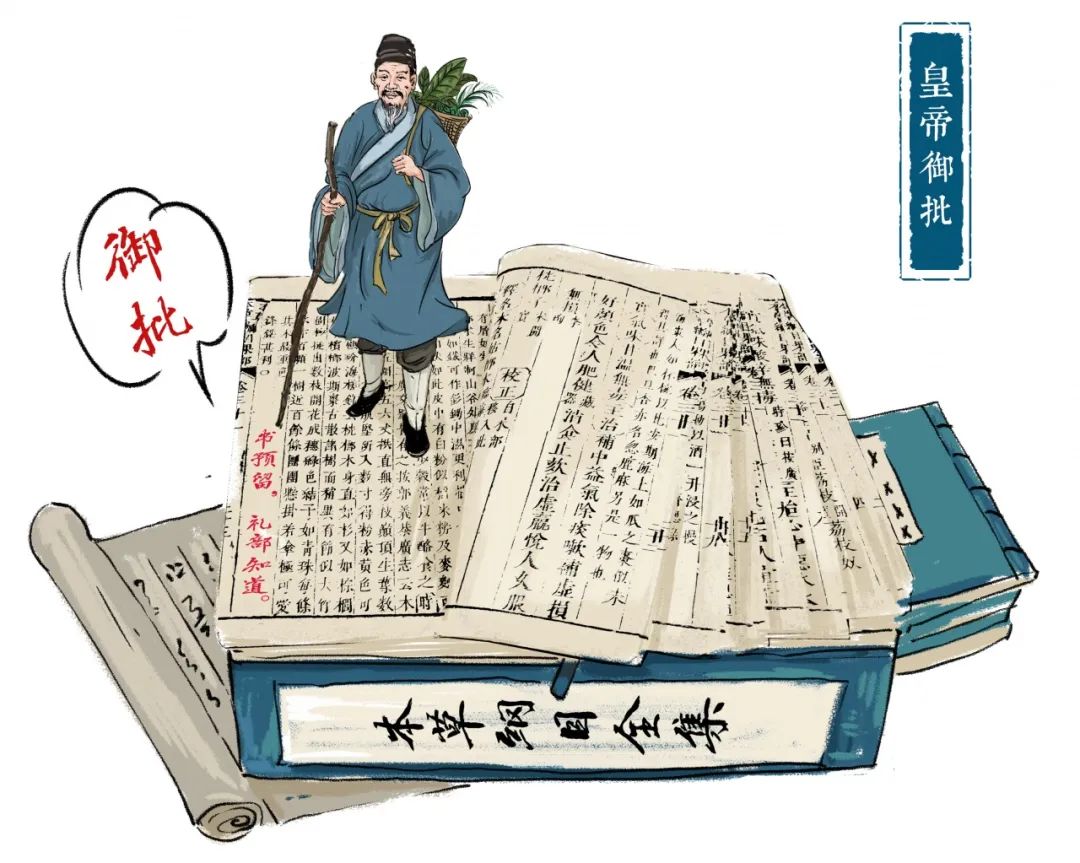
► The emperor’s decree “The book remains for review, the Ministry of Rites is informed” made this book a classic.
One result of informing the Ministry of Rites was the posthumous awarding of the title of Taixue Hospital Judge (a sixth-rank honorary title), equivalent to a departmental-level official today. During his lifetime, Li Shizhen had already received two titles: one for his outstanding medical skills, recommended for a position in the Chu Wangfu (the residence of the King of Chu), and the other due to his eldest son Li Jianzhong’s official position, receiving the honorary title of Wenlin Lang, magistrate of Pengxi (a seventh-rank honorary title). Young Li Shizhen did not achieve fame through the imperial examination but gained recognition from the court posthumously through his work. In his later years, he worked tirelessly for over a decade to publish the Ben Cao Gang Mu, yet he passed away before seeing it printed. However, this work became highly sought after and renowned both domestically and internationally after his death. These were likely things he never dared to imagine.
5
“The Encyclopedia of Ancient China”—— The Eastern Medical Classic Captivates the WorldThe Ben Cao Gang Mu, engraved and printed in Nanjing by Hu Chenglong, is considered the original edition, also known as the Jinling first edition. Due to engraving quality and funding issues, the printing was not very meticulous, and the print run was limited. However, regardless of the quality, this version reflects the original appearance of Li Shizhen’s work to the greatest extent. Currently, only eight copies of the Jinling edition are known to exist (seven in public collections and one in private collection).After the Jinling edition was published, the Ben Cao Gang Mu was reprinted four times during the Ming Dynasty, and by the Chongzhen era, this initially overlooked book had become widely circulated and highly regarded. After entering the Qing Dynasty, the book was repeatedly reprinted by various families, and by 1912, there were 61 versions of the Ben Cao Gang Mu. To date, there are over 100 Chinese versions of this book.Li Shizhen has been honored with titles such as “the saint of medicine” and “a great natural scientist” from various circles.Moreover, the Ben Cao Gang Mu is highly regarded internationally, having reached Europe in the 18th century and was first translated into French in the 1735 edition of the General History of the Chinese Empire. Subsequently, English, German, Russian, and Latin versions appeared, sparking great interest among European scholars.British biologist Charles Darwin cited the Ben Cao Gang Mu over a dozen times in his 1859 work The Origin of Species, referring to it as “the encyclopedia of ancient China.” In the late 19th century, Russian physician Belev praised the Ben Cao Gang Mu as a classic of Chinese materia medica, stating, “Li is undoubtedly an outstanding writer in the field of natural science in China.” British scholar Joseph Needham regarded the Ben Cao Gang Mu as the greatest scientific achievement of the Ming Dynasty, and placed its author, Li Shizhen, alongside Galileo and Vesalius as giants of the Western Renaissance.If Li Shizhen were aware of this, he would surely feel immense satisfaction!
This article is exclusively reported by the “Cultural Tourism China” client.
Comic Creation:Huang Zhuo

Recommended Reading

Media from multiple countries focus on TCM’s role in combating the pandemic: TCM has unique effects, and the combination of Chinese and Western medicine is very effective.
People’s Daily: Why is TCM effective in treating severe cases?
Academician Zhan Qimin: Some thoughts on cultivating public health talents in the post-pandemic era.
Treating coronary heart disease can involve the five organs and expelling pathogens.
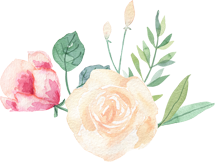

Academic Studies on Theory, Method, and Formulas
Disseminating valuable TCM information
Supporting the inheritance and innovative development of TCMA platform that TCM practitioners are paying attention toWe are waiting for you to follow us
Do you think this is good? Click here↓↓↓

